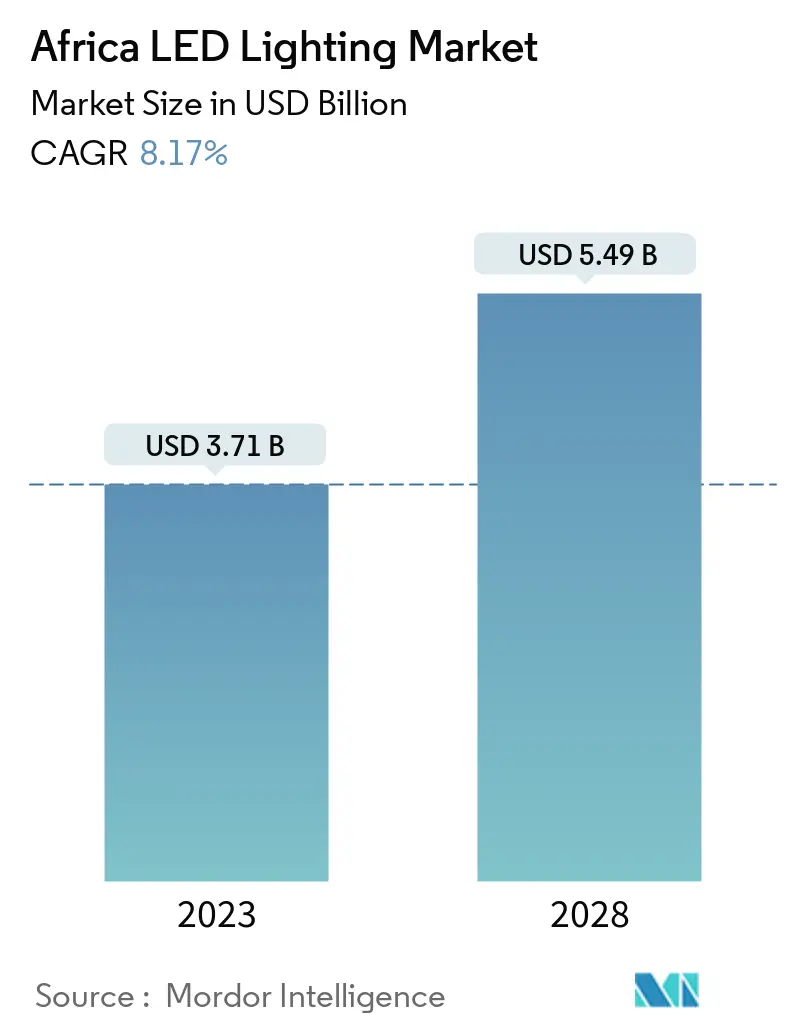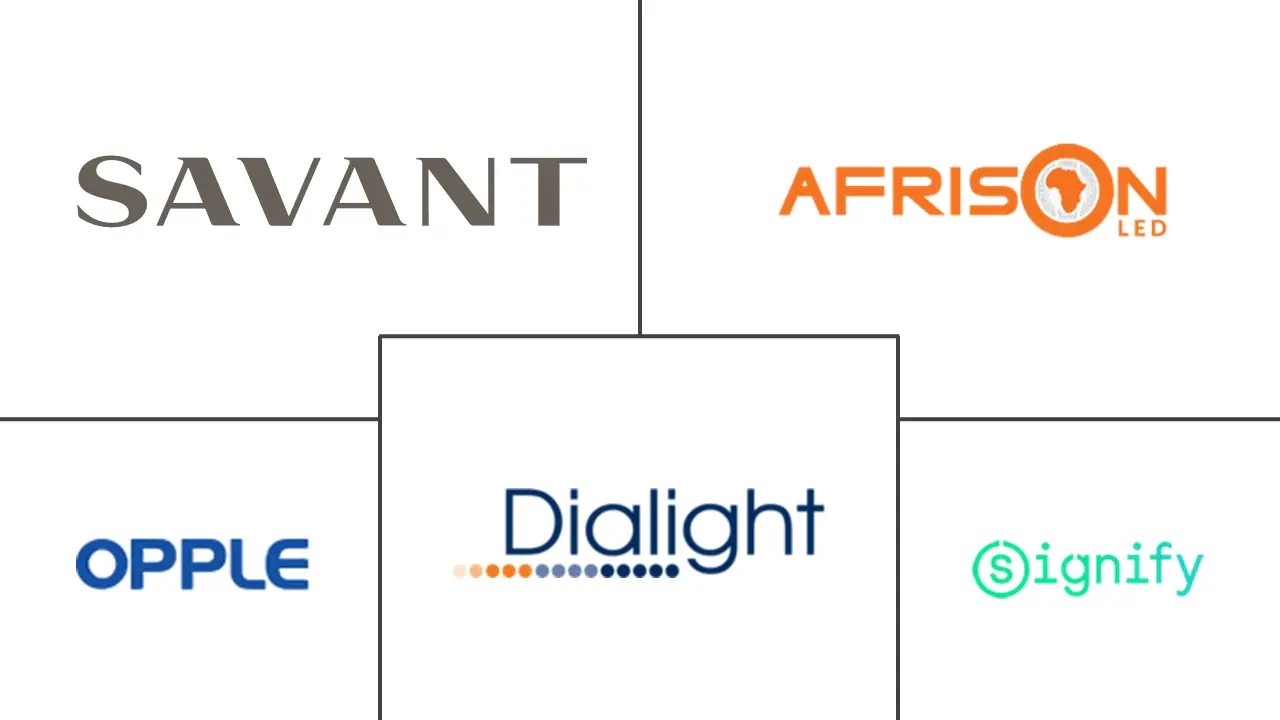Market Size of Africa LED Lighting Industry

| Study Period | 2019 - 2029 |
| Base Year For Estimation | 2023 |
| Market Size (2024) | USD 4.01 Billion |
| Market Size (2029) | USD 5.94 Billion |
| CAGR (2024 - 2029) | 8.17 % |
| Market Concentration | Medium |
Major Players
*Disclaimer: Major Players sorted in no particular order |
Africa LED Lighting Market Analysis
The Africa LED Lighting Market size is estimated at USD 4.01 billion in 2024, and is expected to reach USD 5.94 billion by 2029, growing at a CAGR of 8.17% during the forecast period (2024-2029).
The LED technology is taken over pretty much every application of lighting, as the LEDs are more reliable, robust, more power-efficient, and cleaner sources of light compared to the other conventional sources like Compact Fluorescent Lamps (CFLs) and incandescent lights.
- Light Emitting Diode, or LED, is the electronic component comprising a semiconductor chip, emitting light as current passes through it. The transition of electrons among the energy bands results in a release of energy in the form of light. An array of small LEDs on a chipset or a vertical array is used as a light source, sold commercially in different forms, including lamps, batons, bulbs, strips, etc. LEDs are environment-friendly compared to other light alternatives and are gaining popularity worldwide, including in Africa.
- Since other light sources come with harmful heating effects and greenhouse gases, LEDs are promoted internationally to tackle the detrimental impact of different lighting options. The use of LED helps address the power shortage and the carbon footprints directly and indirectly. Hence, governments in the African region are also promoting the use and sales of LEDs. For instance, according to africa.com, in May 2021, an amendment has proposed the representatives from Africa to the Minamata Convention on Mercury. The restraint from the special exemptions for mercury in lighting would pave the way for LED for mass adoption, relieving the power grids through energy-saving across the regions.
- However, the penetration of electricity remains a major hurdle, affecting the demand for LED lighting. Government and private organizations are looking forward to expanding the reach of electricity through off-grid power alternatives and boosting conventional and renewable energy generation projects. For instance, according to the African Development Bank Group, in February 2022, South African Redstone concentrated solar power (CSP) project achieved its first debt drawdown on one of the major renewable energy investments in South Africa. The African Development Bank acted as the Mandated Lead Arranger (MLA) and Coordinating Bank for the ZAR 11.6 billion total investment, committing ZAR 2.306 billion to the transaction.
- The economic decisions after the COVID-19 pandemic have affected African countries' general economic and trade activities. Importing items from Chinese counterparts and other countries has challenged the local manufacturers. However, new local entrants in the market, along with decent investments for LED lighting manufacturers, will continue the growth of the sector in the region.
Africa LED Lighting Industry Segmentation
Light Emitting Diodes (LEDs) offer clean and efficient light source for various application. Their wide use helps in energy saving compared to the traditional light alternatives. Africa LED Lighting Market is segmented by light type (lamp/Bulb and luminaire/fixture), by application (residential/consumer, commercial/architecture, industrial, and outdoor), by distribution channel (direct sales and wholesale-retail/architects/consultant), and by geography.
| Segmentation - By Light Type | |
| Lamp/Bulb | |
| Luminaire/Fixture |
| Segmentation - By Application | |
| Residential/Consumer | |
| Commercial/Architecture | |
| Industrial | |
| Outdoor |
| Segmentation - By Distribution Channel | |
| Direct Sales | |
| Wholesale Retail/Architects/Consultants & Others |
| Segmentation - By Geography | |
| Egypt | |
| South Africa | |
| Nigeria | |
| Rest of Africa |
Africa LED Lighting Market Size Summary
The Africa LED lighting market is poised for significant growth, driven by the increasing adoption of LED technology across various applications. LEDs are favored for their reliability, robustness, and energy efficiency compared to traditional lighting sources like CFLs and incandescent lights. The transition to LED lighting is further supported by environmental considerations, as LEDs are more eco-friendly and help reduce carbon footprints. Governments across Africa are actively promoting LED adoption to alleviate power shortages and reduce greenhouse gas emissions. Initiatives such as the Clean Lighting Coalition aim to eliminate harmful substances like mercury from lighting products, facilitating the broader adoption of LED solutions. Despite challenges like limited electricity penetration in some regions, efforts to expand electrical grids and promote renewable energy sources are expected to bolster the demand for LED lighting.
The market landscape in Africa is characterized by moderate to high fragmentation, with numerous local entrants contributing to the competitive environment. The affordability of essential manufacturing equipment has lowered entry barriers, allowing new players to offer LED products locally. This dynamic is further enhanced by government programs supporting sustainable energy and electrification, which attract investment and create employment opportunities. The region's industrialization and increasing participation in the Global Value Chain (GVC) are driving demand for energy-efficient lighting solutions. As countries prioritize local manufacturing and trade, projects like the installation of BEKA Schréder's Ecobay LED solutions in South Africa exemplify the mutual benefits of economic growth and energy efficiency. The ongoing developments in the African LED lighting market indicate a promising trajectory, with significant potential for expansion and investment.
Africa LED Lighting Market Size - Table of Contents
-
1. MARKET INSIGHTS
-
1.1 Market Overview
-
1.2 Industry Attractiveness - Porter's Five Forces Analysis
-
1.2.1 Bargaining Power Of Suppliers
-
1.2.2 Bargaining Power Of Buyers
-
1.2.3 Threat Of New Entrants
-
1.2.4 Threat Of Substitutes
-
1.2.5 Intensity Of Competitive Rivalry
-
-
1.3 Value Chain Analysis
-
1.4 Assessment of the Impact of Covid-19 on the Market
-
-
2. MARKET SEGMENTATION
-
2.1 Segmentation - By Light Type
-
2.1.1 Lamp/Bulb
-
2.1.2 Luminaire/Fixture
-
-
2.2 Segmentation - By Application
-
2.2.1 Residential/Consumer
-
2.2.2 Commercial/Architecture
-
2.2.3 Industrial
-
2.2.4 Outdoor
-
-
2.3 Segmentation - By Distribution Channel
-
2.3.1 Direct Sales
-
2.3.2 Wholesale Retail/Architects/Consultants & Others
-
-
2.4 Segmentation - By Geography
-
2.4.1 Egypt
-
2.4.2 South Africa
-
2.4.3 Nigeria
-
2.4.4 Rest of Africa
-
-
Africa LED Lighting Market Size FAQs
How big is the Africa LED Lighting Market?
The Africa LED Lighting Market size is expected to reach USD 4.01 billion in 2024 and grow at a CAGR of 8.17% to reach USD 5.94 billion by 2029.
What is the current Africa LED Lighting Market size?
In 2024, the Africa LED Lighting Market size is expected to reach USD 4.01 billion.

